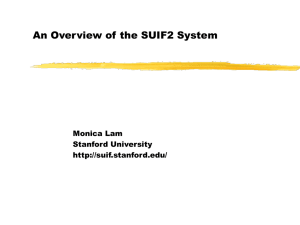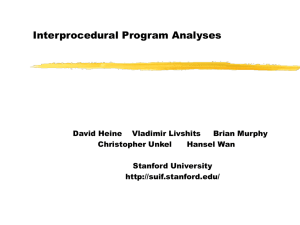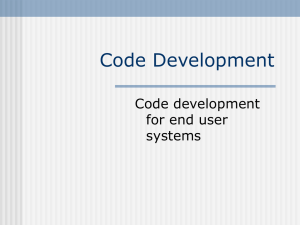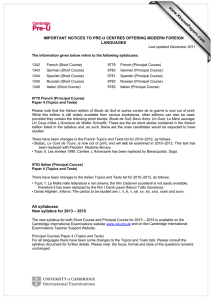An Overview of the SUIF2 System Monica Lam Stanford University
advertisement
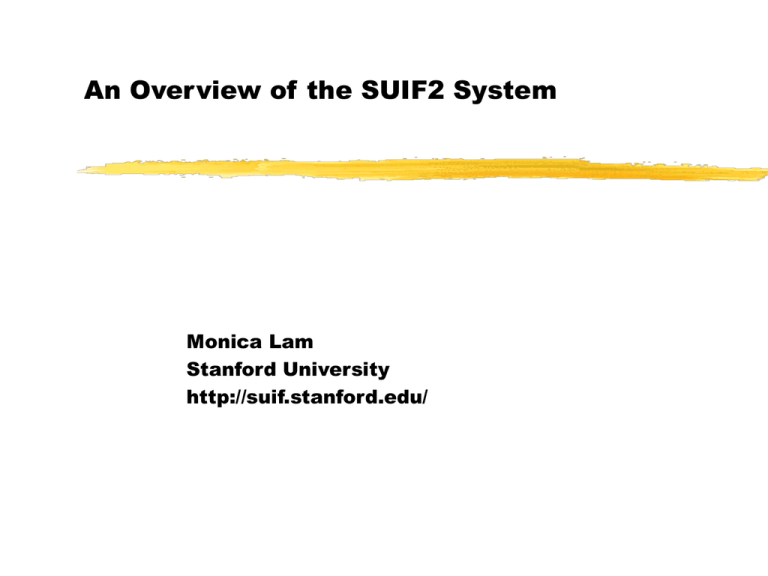
An Overview of the SUIF2 System
Monica Lam
Stanford University
http://suif.stanford.edu/
The SUIF System
PGI Fortran EDG C
EDG C++
Java
OSUIF
Interprocedural
Analysis
Parallelization
Locality Opt
C
SUIF2
*
MachSUIF
Alpha
* C++ OSUIF to SUIF is incomplete
Scalar opt
Inst. Scheduling
Register Allocation
x86
Overview of SUIF Components (I)
Basic Infrastructure
Extensible IR and utilities
Hoof: Suif object specification lang
Standard IR
Modular compiler system
Pass submodule
Data structures (e.g. hash tables)
Object-oriented Infrastructure
OSUIF representation
Backend Infrastructure
MachSUIF program representation
Optimization framework
FE: PGI Fortran, EDG C/C++, Java
SUIF1 / SUIF2 translators, S2c
Interactive compilation: suifdriver
Statement dismantlers
SUIF IR consistency checkers
Suifbrowser, TCL visual shell
Linker
Java OSUIF -> SUIF lowering
object layout and method dispatch
Scalar optimizations
common subexpression elimination
deadcode elimination
peephole optimizations
Graph coloring register allocation
Alpha and x86 backends
Overview of SUIF Components (II)
High-Level Analysis Infrastructure
Graphs, sccs
Iterated dominance frontier
Dot graph output
Region framework
Interprocedural analysis framework
Presburger arithmetic (omega)
Farkas lemma
Gaussian elimination package
Intraprocedural analyses
copy propagation
deadcode elimination
Steensgaard’s alias analysis
Call graph
Control flow graphs
Interprocedural region-based analyses:
array dependence & privatization
scalar reduction & privatization
Interprocedural parallelization
Affine partitioning for parallelism & locality
unifies:
unimodular transform
(interchange, reversal, skewing)
fusion, fission
statement reindexing and scaling
Blocking for nonperfectly nested loops
Motivation for Extensible IR
Suif1 design
A fixed set of flat C++ classes
All codes must change if we add new IR nodes
e.g. printing objects, reading and writing to file
Higher level semantic objects
OSUIF (for object-oriented programming)
Verilog event-driven control flow semantics
Saturated arithmetic used in multimedia instruction sets
Program analysis concepts
Phi nodes in SSA analysis
Synchronization operations introduced by parallelization
Results of analysis
Concept I: Reflective IR
Metaclass: captures representation of IR nodes in a data structure
Enables common generic routines to implement
Persistence: reading/writing to disk
Cloning: routine that copies the data structure
Printing: a generic routine to print out the information
Walkers, iterators, visitors
Concept II:
Object hierarchy & virtual aggregate fields
ExecutionObject
Statement
get_child_statements
IfStatement
WhileStatement
get_then_part
get_else_part
get_body
Abstract names to refer to fundamental concepts in subclasses
e.g. Statement::get_child_statements at Statement level
IfStatement: get_then_part and get_else_part, or
WhileStatement: get_body
Allows a pass to run on representation with extended semantics
without recompilation
e.g. Reuse a dead code elimination on SPMD code without
recompilation
Concept III: Multiple Representations for HighLevel Analyses
Multiple representations for different semantic levels
e.g. FOR loops versus basic blocks in a control flow graph
=> Alternative representations
Mixture of high-level and low-level constructs
Dismantlers lower the representation
Concept IV: High-level object specification
Insulates user from details
Object Definition (.hoof)
SUIF Macro Generator
a general grammar-based tool
Interface for user (.h)
Implementation in
Meta-Class System (.cpp)
Meta-Class System
reading & writing to file in
machine-independent format
• Easy for the programmer
• Easy for the implementor to develop the system
Example of a Hoof Definition
C++
hoof
concrete New
{ int x; }
class New : public SuifObject
{
public:
int get_x();
void set_x(int the_value);
~New();
void print(…);
static const Lstring get_class_name();
…
}
Uniform data access functions (get_ & set_)
Automatic generation of meta class information etc.
Examples of Suif Nodes
abstract Statement : ExecutionObject
{
virtual list<Statement* owner> child_statements;
...
}
concrete IfStatement : Statement
{
Expression * condition in source_ops;
Statement * owner then_part in child_statements;
Statement * owner else_part in child_statements;
}
Motivation for a Modular Compiler System
SUIF1:
All passes read and write suif files:
more modular and supportive of experimentation
but it is slow
Data between passes are written out as annotations
Annotations must be expressed as strings when written out
Requires manual pickling of annotations
Nontrivial effort to support any interactivity
SUIF2
Concept I: A Modular Compiler Architecture
Executable
suifdriver
MODULES:
Passes
analyses
optimizations
Kernel
suifkernel
iokernel
IR
suifnodes
basicnodes
Components
Kernel: provides all basic functionality
iokernel: implements I/O
suifkernel: hides iokernel and provides modules support, cloning,
command line parsing, list of factories, etc.
Modules
passes: provides a pass framework
IR: basic program representations
Suifdriver
provides execution control over modules and passes
Concept II:
Dynamic Registration & Interactive Compilation
Each module (a C++ class) has a unique module_name
A DLL (dynamically linked library) has one or more modules
Register its modules dynamically (init_<dllname>)
An interactive SUIF compiler
> suifdriver
suif> require basicnodes suifnodes
suif> require mylibrary
suif> load test.suif
suif> mylibrary_pass1
suif> print test.out
suif> save test.tsuif
The Suifdriver:
has a set of pre-registered modules (require, load, print, save)
imports libraries dynamically which can register new modules (new
commands)
System can be used for demand-driven program analysis.
Memory/Memory vs File/File Passes
COMPILER
A series of stand-alone programs
Suif-file1
driver+module1
Suif-file2
driver+module2
Suif-file3
A driver that imports & applies
modules to program in memory
Suif-file1
Suifdriver
imports/executes
module1
module2
module3
driver+module3
Suif-file4
Suif-file4
Concept III: Easy to write a new analysis:
subclass of a pass module
Executable
suifdriver
Passes
analyses
optimizations
Kernel
suifkernel
iokernel
IR
suifnodes
basicnodes
Example Pass: Constant Folding of Procedures
class mypass: public Pass {
public:
mypass(SuifEnv *env, const Lstring &name): Pass(env, name) {}
virtual ~mypass() {}
Module *clone() const {return(Module*) this:}
void do_procedure_definition (ProcedureDefinition* proc_def)
{
if (is_kind_of<Statement>(proc_def->get-body()) {
fold_statements(proc_def->get_body());
}
}
}
extern “C” void init_mypass (SuifEnv *suif_env) {
suif_env->get_module_subsystem()->register_module
(new mypass (suif_env, “mypass”));
}
Research Infrastructure: Support at 3 Levels
I. Compose compiler with existing passes
Dynamic composition of different passes
II. Develop new passes
User concentrates on algorithmic issues
Infrastructure provides common functionalities
Write code once, can run on SUIF program in memory or a file
III. Develop new IR
High-level specification of the IR nodes
Old code works with new IR without recompilation
Status
Base infrastructures are solid
System getting populated with interesting analyses
End of NCI project: PGI will no longer provide support
Relies on community effort
Stanford Team
Gerald Aigner
Gerald Cheong
Amer Diwan
Andrew Fikes
David Heine
Monica Lam
Amy Lim
Vladimir Livshits
Virendra Mehta
Brian Murphy
Costa Sapuntzakis
Christopher Unkel
Hansel Wan
Christopher Wilson
